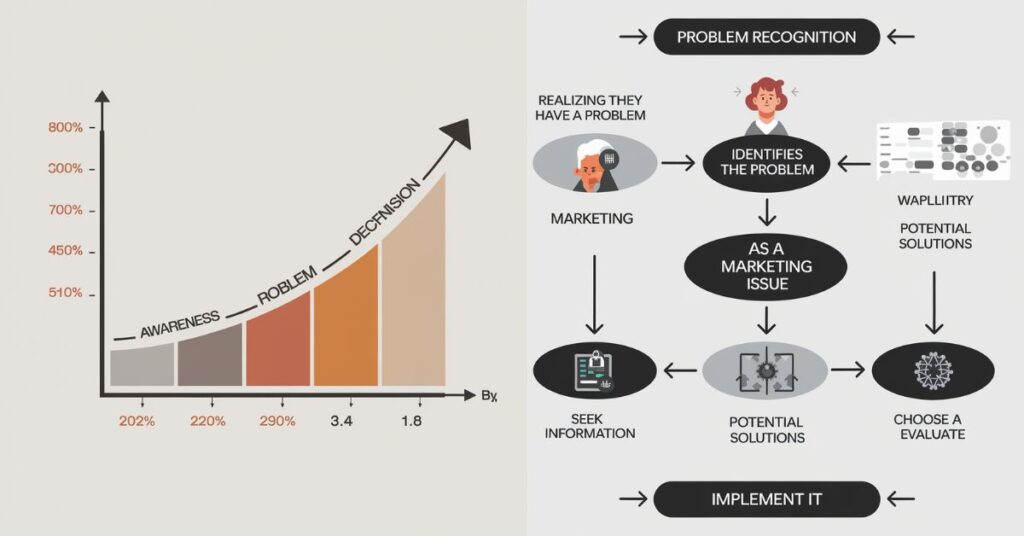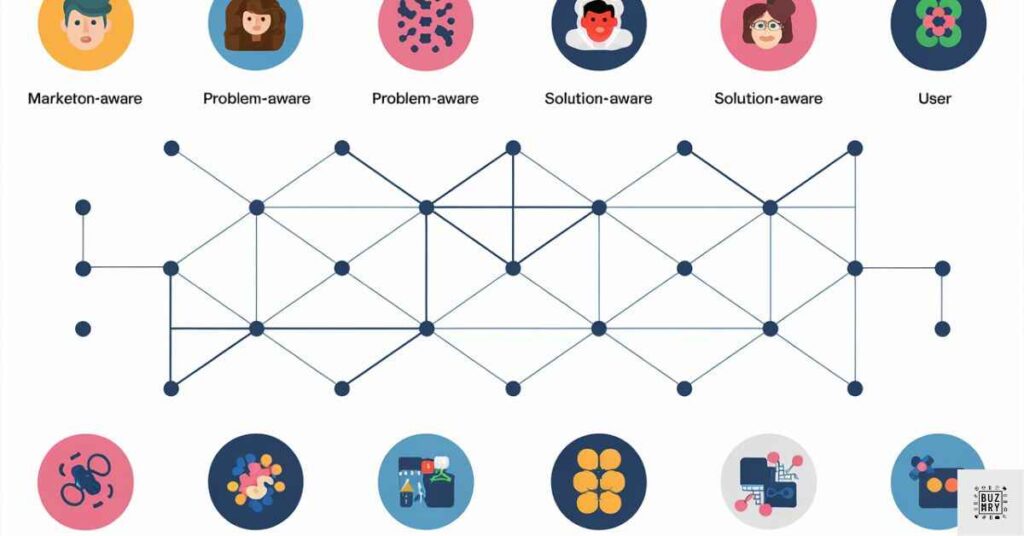The marketing circle is a vital concept in modern marketing strategies. Emphasizing two critical stages, problem awareness and solution awareness. Many businesses find it challenging to guide potential customers effectively. These stages, result in missed opportunities and wasted resources.
Understanding and implementing the marketing circle. Helps companies address customer pain points more precisely and introduce their solutions at the optimal moment. This alignment boosts engagement and conversions, enabling businesses to craft targeted campaigns, enhance customer relationships, and drive growth in a competitive marketplace.
The Evolution of Marketing Strategies
Marketing has changed significantly over time. Early approaches focused on product features and benefits. As markets became more competitive, customer-centric strategies emerged. The marketing circle concept developed as businesses recognized the importance of addressing customer problems.
This shift led to more targeted and effective marketing efforts. Today, the marketing circle guides companies in aligning their strategies with customer needs and awareness levels.
Defining the Marketing Circle
The marketing circle is a framework that describes how customers move from recognizing a problem to finding a solution. It has two main stages: problem awareness and solution awareness. In the problem-aware stage, customers identify their challenges or needs.
The solution-aware stage involves customers seeking and evaluating potential solutions. This concept helps marketers create more relevant and impactful campaigns by addressing customers at each journey stage.
The Problem-Aware Stage
The problem-aware stage is the first part of the marketing circle. During this phase, customers recognize they have a problem or need. They may not yet be actively seeking solutions. Marketers focus on highlighting and defining these problems for their audience.
This stage is crucial for building initial connections with potential customers. Effective communication here sets the foundation for later presenting solutions.
Identifying Customer Pain Points
Understanding customer pain points is essential for effective marketing. Pain points are specific problems or challenges that customers face. To identify these, businesses use various methods:
1. Surveys and feedback forms
2. Social media listening
3. Customer service interactions
4. Market research
5. Analytics data
Companies can tailor their marketing messages to address real customer needs by recognizing pain points.
Creating Problem Awareness
Problem awareness is when your audience realizes they have an issue but don’t know the solution yet. It’s the first step in the marketing circle.
Importance of Problem Awareness
Without problem awareness, your audience won’t see the need for a solution. This stage is crucial for making them understand why they need your product.
How to Create Problem Awareness
Use educational content like blogs, videos, or social media posts. Explain the problem clearly and show its impact on their life or business.
Problem Awareness vs. Solution Awareness
| Aspect | Problem Awareness | Solution Awareness |
| Focus | Identifying the issue | Presenting the solution |
| Audience Knowledge | Knows there’s a problem but not the fix | Aware of possible solutions |
| Marketing Approach | Educational and informative | Persuasive and product-focused |
Tips for Effective Problem Awareness
Keep your content simple and relatable. Use real-life examples to make the problem clear. Always focus on the customer’s pain points.
The Psychology of Problem Recognition

Several psychological factors influence how people become aware of problems:
1. Cognitive dissonance: When current beliefs clash with new information
2. Social proof: Recognizing issues because others have identified them
3. Loss aversion: Realizing potential negative outcomes
4. Anchoring bias: Comparing the current situation to an ideal state
5. Availability heuristic: Recent or memorable experiences highlighting problems
Transitioning from Problem to Solution Awareness
Moving customers from recognizing a problem to seeking solutions is a critical step. This transition marks a shift in customer mindset. They go from understanding their issue to actively looking for ways to solve it. Marketers must guide this process carefully. The right messaging at this stage can turn potential customers into active prospects. Timing and relevance are key factors in successfully navigating this transition.
Bridging the Gap
Bridging the gap means helping your audience move from just knowing they have a problem to understanding how your solution can help them. It’s the middle step in the marketing circle.
Importance of Bridging the Gap
This step connects your audience’s problem with your solution. It makes them see why your product is the best way to fix their issue.
Read This Blog: Rebekka Thor Thor Marketing: Elevating Your Business To New Heights
How to Bridge the Gap
Use clear and simple content that shows how your product solves the problem. Share success stories, examples, or comparisons to make it easy to understand.
Bridging the Gap vs. Awareness Stages
| Aspect | Problem Awareness | Bridging the Gap | Solution Awareness |
| Focus | Identifying the problem | Connecting problem with solution | Understanding and considering the solution |
| Audience Knowledge | Knows they have a problem | Learning about possible solutions | Knows about your solution |
| Marketing Approach | Informative and educational | Explanatory and relatable | Persuasive and product-focused |
The Role of Education in the Transition
Solution awareness is key to helping customers see the full picture. It helps them understand their problems better, explore various solutions, and recognize the benefits of addressing their issues. By providing valuable information, you empower them to make informed decisions and build trust in your brand as a knowledgeable resource. This approach not only establishes credibility but also positions your brand as a supportive partner in solving their problems.
The Solution-Aware Stage
The solution-aware stage is when customers actively seek ways to solve their recognized problems. They’re now open to learning about specific products or services. At this point, customers compare different options. Marketers focus on showcasing their solutions’ benefits and unique features. The goal is to position their offering as the best choice. Effective communication during this stage can turn prospects into customers.
Introducing Solutions to Aware Customers
When introducing solutions to aware customers, focus on the specific benefits your product offers. Use simple, clear language without jargon.Marketing circle problem aware solution aware. Provide detailed information about how your product works. Offer demos or free trials to let customers experience it firsthand. Share success stories from other customers to build trust. The goal is to show clearly how your solution solves their problem and highlights its value.
Differentiating Your Solution.
To differentiate your solution in a crowded market, highlight what makes it unique. Emphasize its superior quality or performance compared to others. Offer exceptional customer service to stand out. Provide a better price-to-value ratio to attract budget-conscious buyers. Focus on a specific niche or use case where your solution excels. Communicate these points to help customers see why your offering is the best choice.
Building Trust in Your Solution
To build trust in your solution, share positive customer testimonials and reviews to show satisfaction. Be transparent with pricing and policies so customers know what to expect. Offer strong guarantees or warranties to back your product.
Highlight any industry certifications or awards you have earned. Demonstrate your expertise with helpful content. Building trust is key to turning prospects into loyal customers and proving your solution’s reliability.
Implementing the Marketing Circle in Your Strategy
Identify your target audience’s main problems. Create content that addresses these issues. Develop solutions that match customer needs. Design campaigns for both problem and solution awareness. Track customer progress through the circle.
Then, create a strategy that guides them from problem recognition to choosing your solution. This approach ensures your marketing efforts align with customer needs at each stage.
Aligning Content with the Marketing Circle
Problem Awareness:
Blog posts about industry challenges
Infographics highlighting common issues
Quizzes to help identify problems
Solution Awareness:
Product comparison guides
Case studies showing successful outcomes
Demo videos of your solution in action
Ensure your content addresses customer needs at each stage. This helps guide them through the entire marketing circle.
Mapping Customer Journeys to the Marketing Circle
To map customer journeys in the marketing circle, start by creating detailed buyer personas to understand your audience. Identify key touchpoints where they interact with your brand at each stage. Use analytics to track their behavior and see how they move through the process.
Gather feedback through surveys to learn about their experiences. Analyze sales data to spot patterns. This helps you see how customers progress and improve your marketing strategy.
Measuring Success in the Marketing Circle
To measure success in the marketing circle, track key metrics. Monitor engagement rates for content aimed at problem-aware customers. Check click-through rates on ads focused on solutions. Measure conversion rates at each stage to see how well you’re moving customers through.
Track how much time they spend at each stage. Keep an eye on customer acquisition costs. Regularly review this data to refine your strategy and improve results.
Also Read Blog: Industrial Marketing Challenges: Best Practices for 2024
Advanced Techniques in the Marketing Circle
To enhance the marketing circle, use data analytics to understand customer behavior better. Implement AI-powered personalization to tailor experiences to individual needs. Create interactive content that engages customers at each stage.
Develop omnichannel strategies to connect with customers across various platforms. Utilize predictive modeling to anticipate customer needs. These advanced techniques help create more targeted marketing campaigns and improve engagement throughout the marketing circle.
Personalization in Problem and Solution Awareness
Personalization boosts marketing effectiveness by addressing individual needs. Start by segmenting your audience based on their behavior and preferences. Tailor your content to address specific customer pain points. Use dynamic website content that changes based on user interactions.
Create personalized email campaigns to reach customers more effectively. Offer customized product recommendations that match their interests. This approach increases engagement and conversion rates, making customers feel understood and valued.
Multi-Channel Marketing Circle Strategies
To effectively implement the marketing circle, use multiple channels. Engage customers on social media platforms with targeted content. Use email marketing to keep in touch and share updates. Create valuable content like blogs and videos to educate and inform.
Invest in paid advertising to reach a broader audience. Host in-person events or webinars for direct engagement. A multi-channel approach ensures your message is consistent and reaches customers where they are most active.
Automation in the Marketing Circle
Automation can boost efficiency in the marketing circle. Set up automated email sequences to nurture leads with timely messages. Use chatbots to handle initial customer interactions and answer common questions. Implement lead scoring systems to prioritize and manage prospects.
Create triggered content delivery to send relevant information based on user actions. Automate social media posting to keep your brand active and engaged. Automation saves time and ensures your communication is timely and relevant.
Overcoming Challenges in the Marketing Circle
Difficulty identifying customer problems, Marketing circle problem aware solution aware. Conduct thorough market research. Misalignment of messaging and regularly review and adjust your content strategy. Slow customer progression to Improve nurturing processes.
Measuring ROI and Implementing better tracking and attribution models. Resource constraints and Prioritize efforts based on potential impact. Addressing these challenges helps improve the effectiveness of your marketing circle strategy.
Dealing with Misalignment Between Problem and Solution
When customer problems don’t match your solution:
1. Reassess your target audience
2. Refine your product or service offering
3. Improve your messaging to highlight relevant benefits
4. Explore new market segments
5. Consider pivoting your business model if necessary
Alignment between customer problems and your solution is crucial for success. Be willing to adapt your approach based on customer needs.
Handling Competition in the Awareness Stages
To stand out from competitors:
1. Focus on unique selling points
2. Provide superior customer education
3. Offer exceptional customer service
4. Create more engaging content
5. Build stronger brand loyalty
Differentiation is key when competitors target the same problems and solutions. Find ways to add unique value at each stage of the marketing circle.
Adapting to Changing Customer Awareness Levels
As customers become more informed:
1. Regularly update your content
2. Provide more in-depth, advanced information
3. Offer new perspectives on familiar problems
4. Address emerging issues in your industry
5. Engage in thought leadership
Stay ahead of your audience by continuously evolving your marketing approach. This helps maintain relevance and authority in your field.
Case Studies: Successful Marketing Circle Implementations
Real-world examples help illustrate effective strategies. They provide practical insights and inspiration for your own marketing efforts. Case studies show how different companies have applied the marketing circle concept successfully. They often include challenges faced, solutions implemented, and results achieved.
B2B Marketing Circle Success Story
A software company boosted lead generation with several effective strategies. They created content focused on industry challenges to raise problem awareness. They offered free tools to help identify specific issues.
Detailed whitepapers were provided on possible solutions. Targeted webinars showcased their product. A nurture campaign was implemented for leads at various stages. These efforts led to a 40% increase in qualified leads and a 25% higher conversion rate.
B2C Marketing Circle Triumph
A fitness equipment brand achieved success with several strategies. They ran social media campaigns highlighting health risks of a sedentary lifestyle. They offered free fitness assessment tools on their website. Created video content showing the benefits of their equipment.
Personalized email marketing was used based on user interests. They also partnered with influencers to build trust. These efforts resulted in a 50% increase in website traffic and a 30% boost in online sales.
The Future of the Marketing Circle
The future of the marketing circle includes several key trends. There will be a greater focus on micro-moments, capturing customers’ immediate needs. Offline and online experiences will become more integrated for a seamless journey. Building communities around shared problems will grow in importance.
Voice and conversational marketing will rise, making interactions more personal. Enhanced use of predictive analytics will improve personalization. Staying updated with these trends will help you adapt and succeed.
Emerging Technologies and the Marketing Circle
Emerging technologies are transforming marketing strategies. AI helps with advanced customer segmentation and personalization, making your messages more relevant. VR and AR create immersive product demonstrations, enhancing customer experiences.
Voice search optimization helps with both problem and solution awareness by improving search visibility. Blockchain ensures transparent customer data management, building trust. IoT enables real-time identification of customer problems. These technologies improve engagement and make the marketing circle more effective.
Ethical Considerations in Awareness Marketing
Ethical marketing is essential for building trust and loyalty. Avoid creating false problems or exaggerating issues to attract attention. Provide honest and clear information about your solutions.
Respect customer privacy when collecting and using data. Ensure your marketing content is accessible to everyone. Consider the societal impact of your messages. Ethical practices lead to long-term success and build strong relationships with informed consumers.
Conclusion
Mastering the marketing circle is crucial. long-term success, especially when guiding customers. From being problem-aware to solution-aware. Marketing circle problem aware solution aware. By understanding the stages of awareness. Businesses can tailor their messaging to resonate.
With potential customers at ea ch step. This approach ensures that marketing efforts. Targeted and effective, leading to better engagement and higher conversion rates. Implementing an effective marketing circle strategy. Require continuous refinement, staying attuned to customer needs. Adapting to market changes, ultimately driving sustainable growth and success.
Frequently Asked Question
What is the difference between problem-aware and solution-aware marketing?
Problem-aware marketing identifies and educates customers about their pain points, while solution-aware marketing presents your product as the answer.
How can I identify if my audience is problem-aware or solution-aware?
Analyze customer behavior and feedback to determine if they recognize their problem or are searching for a specific solution.
What are the best channels for problem-aware marketing?
Content marketing, social media, and educational blogs are effective channels for reaching problem-aware audiences.
How long does it typically take to move a customer from problem-aware to solution-aware?
The transition time varies, depending on the complexity of the problem and the effectiveness of your marketing.
Can the marketing circle be applied to all industries?
Yes, the marketing circle is versatile and can be adapted to suit any industry.
How often should I reassess my marketing circle approach?
Reassess quarterly or whenever significant market changes occur to stay aligned with customer needs. Yes, if the audience is already aware of their problem, you can focus directly on the solution.
How can I create content that addresses both problem and solution awareness?
Create content that educates on the problem while subtly introducing your solution as the best option.
What role does customer feedback play in refining the marketing circle strategy?
Customer feedback is crucial for identifying gaps and making necessary adjustments to improve your strategy.
Mr. Harry is the author of the business category on buzsmarty.com. With a keen understanding of market trends, he provides practical insights to help readers navigate the business world. His writing is clear, concise, and focused on delivering actionable advice. Mr. Harry’s expertise makes complex topics accessible to everyone, empowering readers to achieve their business goals.



